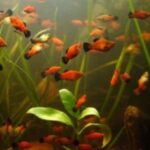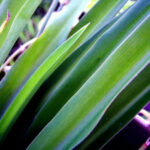Those who have been unable to grow plants in aquariums or those considering starting an aquarium might note that the most frequent reason for failure of plants in aquariums is improper light – usually poor light. Before the development of artificial lights, aquariums were usually located near a window. A south-facing window, where maximum light could be obtained, was thought to be best. With the development of artificial lighting, aquariums were placed away from windows where they were often more attractive in the room decor. However, lights used to display them were often inadequate for proper plant growth.
Even though an aquarium may have artificial light, a better light balance and distribution is possible in the aquarium if it is located where window light can supplement the artificial light. Plant growth often seems best and easiest when a little direct sunlight hits the tank each day. This light must not be excessive, however, or too much algae can grow on the sides of the tank or on leaves of the plants. A location near an east or west window where the aquarium receives only a few hours of sunlight each day in addition to the artificial light seems best.
Run the artificial lights no less than 12 hours a day. Fluorescent tubes are the best source of artificial light for plant growth in the aquarium. A single tube is adequate if the water depth is no more than 12 inches, or if low-light plants are used. In deeper tanks, and for most plants, two or more tubes are usually necessary. A balance must be maintained between window and artificial light. Floating plants present another lighting problem, since they shade plants under them. However, they are an asset to the aquarium, because they help clear the water by trapping debris, provide a hiding place for small or weak fish, and provide shade for fish that do not like bright light.
Again, the slanting rays of the sun from a window help to light plants beneath floating plants. Side lighting may be beneficial for plants growing under floating plants if no other method of lighting can be found. Because healthy floating plants grow rapidly, they should be kept thinned out so they do not become too dense. Cut out the older portions of the plants rather than the vigorous growing tips. Most water plants prefer fairly soft water and grow poorly in hard water. Only a few, such as elodea, are able to survive hard water.
The temperatures and pH required by aquarium plants are about the same as those required by tropical fish. A pH value between 6.8 and 7.0 along with temperatures between 70 and 80 degrees Fahrenheit are best. Do not subject aquarium plants to abrupt changes in temperature. Most aquarium plants can be grown in the aquarium sand or gravel without special soil mixes. Special peat plugs are available in some pet stores to use for planting. Fertilizers are available for aquarium use, but not generally needed in a well-balanced aquarium.
http://www.waterzoo.co.uk/help%20sheets/Growing%20aquarium%20plants.pdf



